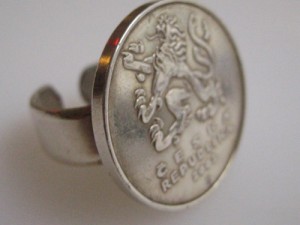 One of the most impressive things about Vienna is the shops – they are varied, stylish and often innovative. But when I went down Schleifmuhlgasse, which is not far from the Opera House, I was stopped in my tracks by the remarkable items in the window and the curious name “Gabarage. Upcycling Design.” The shop window was full of stylish and unusual things made out of waste, like plant pots fashioned from half footballs and lamp shades with strips of old film hanging down like long brown hair.
One of the most impressive things about Vienna is the shops – they are varied, stylish and often innovative. But when I went down Schleifmuhlgasse, which is not far from the Opera House, I was stopped in my tracks by the remarkable items in the window and the curious name “Gabarage. Upcycling Design.” The shop window was full of stylish and unusual things made out of waste, like plant pots fashioned from half footballs and lamp shades with strips of old film hanging down like long brown hair.
It wasn’t the fact that the sign was in English that caught my attention, it was seeing the word “upcycling”. I’d read about upcycling in a remarkable book called Cradle to Cradle, a book which explains that recycling is ineffective; metal from cars, for example, is so impregnated with paints that it’s almost impossible to get the pure metal out of it. So most materials are “down-cycled” – made into lower grade material (car doors are melted down into low grade alloy). Paper, for example, which is full of chalk and paint, ends up becoming egg boxes or packaging material. We should be “up-cycling” which means using the high quality material that makes up most products as a raw material for the production of similar (or better) quality products.
So I knew about upcycling and I agreed with the authors of Cradle to Cradle that this concept has the potential to eliminate waste altogether from the manufacturing process. But I had never seen upcyling in practise – until I went into the “Gabarage” shop in Schleifmuhlgasse which is in Vienna’s fourth district.
The word “Gabarage” is a play on the word “garage” and “garbage”. It’s also one of the most unusual business models I’ve come across in my travels across Central and Eastern Europe. Ostensibly it is a shop but it also functions as a workshop, or garage, for “25 people who were addicted to illegal substances”. These former addicts are employed to create works of art out of various types of waste. They turn garbage into designer items which are then sold at a premium.
And the “designer items” on display are stylish and hard wearing. Their best selling item are chunky shoulder bags made from the hard wearing rubbery tarpaulin that is used on the sides of trucks and on outdoor advertising hoardings (material that is virtually indestructible and usually gets discarded). Although each one is different, and all of them are stylish, I did find the prices a bit steep (starting at 30 Euros) and I asked myself “Is this not made of trash? Is it art? Am I paying a premium for a well designed product?”
They also have seats made from old street bins, earrings from shuttlecock feathers and bits of puzzle, necklaces from thin strips of black rubber cut from bicycle inner tubes, big round lamps hanging from the ceiling made up from the coloured glass lenses from traffic lights, notebooks from linoleum and wallets made from strips of that silky but incredibly strong material that we all use daily (but rarely think about) – car seat belts. It’s an Aladdin’s Cave of amusing, original, stylish and hard wearing gear.
Despite the high prices, Garabage is not entirely funded by the sale of it’s designer items (most galleries and designer shops only have a couple of employees, this place has over 25; imagine their wage bill). It’s main subsidy comes from the Anton Proksch Institute (API) which is one of Europe’s biggest centres for the rehabilitation of people with drug (and mainly) alcohol addictions. Located on the outskirts of Vienna, near Liesing, the API consists of a series of low rise buildings around a park. They treat over 12,000 addicts a year at Liesing and also in a number of out-patient clinics around Austria.
Michael Musalek, the director of API, explained to me that the garbage concept is central to their whole treatment programme – as well as to the shop Gabarage which he was involved in setting up. He told me that many addicts are seen as trash (or “wasters”) by many people in society and the aim of API’s treatment programme is to transform what people see as waste into art. He said the API’s programme had been partially inspired by the French philosopher Michel Foucault, who said “in our society art has become something which is related only to objects and not to individuals, or to life. That art is something which is specialized or which is done by experts who are artists. But couldn’t everyone’s life become a work of art? Why should the lamp or the house be an art object, but not our life?”
Rupert Wolfe Murray was in Vienna as a representative of Castle Craig, one of Europe’s leading drug and alcohol rehab clinics
While I’ve already heard about ‘upcycling’ design, ‘gabarge’ is a completely new practice to me. People should definitely put much more attention and more care about what and how much they waste. But only few, very creative indeed, are able to turn this need into a form of art. How about one’s life to become a ‘work of art’? I don’t think you need to be an expert in order to produce art. For sure, anybody can create art, but only few are aware of that.